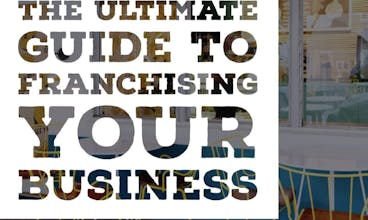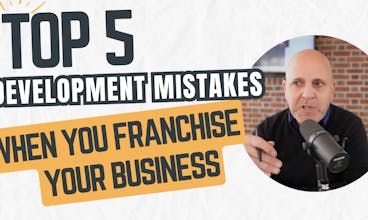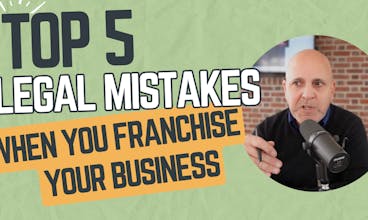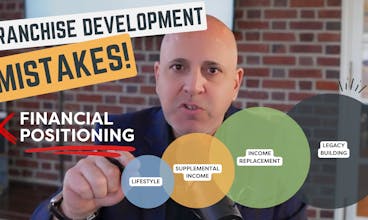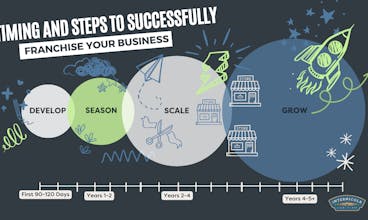What is Franchising?
Franchising is a legal relationship and business model that's used to grow a business by establishing a network of licensed business locations that operate as one brand using common trademarks, product and service standards, and business systems that duplicate the branding and operations of a business. The parties to a franchise relationship are know as the "franchisor" and "franchisee" and the legal agreement that creates a franchise relationship is known as the "franchise agreement."
Franchised businesses operate in a broad range of industries including restaurants, hospitality, business services, personal services, automotive, distribution, and healthcare. Over 11% of businesses tracked by the US Census Bureau are franchises and, according to the International Franchise Associations 2021 Economic Outlook study, franchising employs more than 8 million individuals and contributing to more than 3% of United States Gross Domestic Product. The influence and value of franchising continues to grow in the United States.
Who are the Parties to a Franchise Relationship?
The parties to a franchise relationship are the franchisor and franchisee. A franchisor is the corporate entity that authorizes and grants to a franchisee the license and right to establish a franchised business location using the franchisor's trademarks, branding, business systems, training, and know-how. A franchisee is typically an individual investor that invests his or her own capital to established a franchised business location using the franchisor's trademarks, branding, supply chain, and systems.
What are the Different Types of Franchises?
There a two types of franchises known as business format franchises and product distribution franchises. Business format franchises involve the sale of a franchisor's products and services under the franchisor's trademarks and following the franchisor's systems. Product distribution franchises involve the sale of a franchisor's products under more traditional supplier-dealer relationships. Business format franchises represent the dominant form of franchising in the United States.
What are the Benefits of Franchising?
For franchisors, compared to traditional organic growth where a business owner must invest his or her own capital, time, and managerial efforts in developing and opening new locations, an advantage of franchising is that franchising allows a business and brand to expand by recruiting franchisees that invest their own capital, time, and managerial efforts in opening new locations. For franchisees, compared to establishing a new independent business from scratch, an advantage of franchising is that franchisee's benefit from licensing and adopting a business, brand, supply chain, and systems that should be more readily recognized within the marketplace and that provides a competitive advantage. Franchisee's benefit from established business systems and brand recognition. Learn more about the advantages and disadvantages of franchising.
What are the Franchise Laws?
Franchising and franchise relationships are regulated by the Federal Trade Commission and state franchise laws. The legal agreement that creates a franchise relationship is the franchise agreement and the pre-sales document that franchisors are required to disclose to franchisees is the Franchise Disclosure Document.
Before offering or selling a franchise, franchisors are required to disclose a prospective franchisee with their Franchise Disclosure Document 14 days before accepting any fees or signing any agreements. On-going, franchisors must comply with the franchise laws.
What Does it Mean to Franchise a Business?
Franchising a business means a business owner has taken the legal and business steps necessary to offer and sell franchises, comply with the franchise laws, and to support franchisees. When someone franchises their business they become a franchisor. When someone buys a franchise they become a franchisee. Learn more about how to franchise a business.
What is the History of Franchising?
Franchising dates back as early as the 1500s and 1600s in Europe.
In the United States, elements of the franchising has been noted as early as 1731, when Benjamin Franklin and Thomas Whitmarsh entered into an agreement for printing businesses. However, modern day franchising can trace its roots to Isaac Singer's business model for distributing patented Singer sewing machines, and Martha Matilda's development of the first business format franchise.
Following the patenting of I.M. Singer and Company's sewing machine in 1851, Isaac Singer adopted an innovative business model for selling and distributing its sewing machines. Rather than just relying on a direct to consumer model, Isaac Singer sold licenses to distributors that were granted territories and charged with the responsibility of selling sewing machines and educating customers. The license fees charged by I.M. Singer and Company provided valuable capital that was reinvested in manufacturing and the license structure forms the foundation of today's franchises.
On the retail front, in 1891 Martha Matilda developed what is believed to be one of the first United States retail based franchises, a chain of healthy hair care salons known as Harpers Salon and featuring Martha Matilda's hair tonics. Over time, Martha sold franchises allowing others to operate a Harper's Salon and, at its peak, Martha had over 500 franchises.
As the Industrial Revolution intensified and created opportunities for growth, franchising really began to take off around the start of the 20th century. Franchising, initially, took hold in the automotive, manufacturing and beverage businesses, and, today, has approached and influenced product, distribution, and service based industries.
Below is a timeline of historical dates in franchising in the U.S.:
- 1851: Singer Sewing Machine Patent is Issued.
- 1898: General Motors issued its first franchise to William Metzger of Detroit.
- 1901: Coca-Cola sold its first franchise to the Georgia Coca-Cola Bottling Company.
- 1909: The Western Auto franchise was established, marking one of the first times business-related services like training and marketing help were offered in addition to brand and the supply of product.
- 1924: A&W Root Beer entered into franchising.
- 1925: Hertz started to franchise.
- 1946: The federal Lanham (Trademark) Act was enacted by Congressing, offering a national system of trademark protection and allowing property owners to enter into licenses with third parties in a safe manner.
- 1960: The trade organization International Franchise Association was founded to serve the franchising community.
- 1971: New Jersey becomes one of first states to regulates franchises
- 1979: The FTC franchise rule and regulation goes into effect
Over the next few decades, many notable brands began to franchise, including Kentucky Fried Chicken, Carvel, Dunkin Donuts, Burger King and McDonald's. As branded goods and service chains grew throughout the 1950s and 1960s, so did franchising.
Examples of Franchises Today
Today, there are more than 770,000 franchises in the U.S., and over 8.4 million people employed by franchise establishments, per Statista, a provider of market and consumer data.
Franchises span a wide range of industries, with some of the largest being limited and full-service restaurants, gas stations, hotels and motels and new car dealers, per Census Bureau data. According to Franchise Direct's rankings, which are based on factors like sales revenue, number of locations, years franchising and others, the top 15 global franchises in 2022 are:
- KFC
- 7-Eleven
- McDonalds
- Marriott International
- Burger King
- Pizza Hut
- Taco Bell
- Domino's
- Ace Hardware Corporation
- Century 21
- Subway
- Wendy's
- InterContinental Hotels
- Dunkin'
- Re/Max
Franchising Summary
- Franchising is a business model used to grow a business through licensed locations that operate as one brand using common trademarks and systems
- The parties involved in a franchise relationship are the franchisor and franchisees
- The two types of franchises are business format franchises and product distribution franchises
- Franchised businesses contribute to more than 3% of overall US Gross Domestic Product
- Franchising is regulated by the FTC and state specific franchise laws
- Franchising a business requires compliance with franchise law and regulation
- Modern day franchising traces its roots to the the Singer sewing machine license
- Franchising is global
Franchising FAQ's
As a franchisor, you grow new revenue streams consisting of initial franchise fees, ongoing royalties, and other system generated revenues.
Though there is the potential for franchising to be a win-win relationship, few business propositions are without any risk. Potential disadvantages for franchisors include ensuring you comply with franchise laws, reduced control of their business locations, the sharing of profits and the time and cost of franchising your business. Franchisees, meanwhile, face the risk of financial losses if their franchise location doesn't pan out.
The main difference between licensing and franchising comes down to the scope of the legal relationship. Licensing is a limited relationship in which only the use of the trademark or technology is licensed. With franchising, the relationship is far more extensive, allowing for the use of a business' entire system and brand in order to expand the business.

